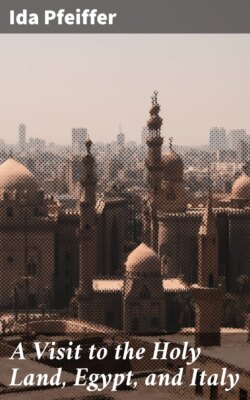Читать книгу A Visit to the Holy Land, Egypt, and Italy - Ida Pfeiffer - Страница 32
На сайте Литреса книга снята с продажи.
EXCURSION TO EJUB,
ОглавлениеTable of Contents
the greatest suburb of Constantinople, and also the place where the richest and most noble of the Turks are buried.
Ejub, the standard-bearer of Mahomet, rests here in a magnificent mosque, built entirely of white marble. None but a Mussulman may tread this hallowed shrine. A tolerably good view of the interior can, however, be obtained from without, as the windows are lofty and broad, and reach nearly to the ground. The sarcophagus stands in a hall; it is covered with a richly embroidered pall, over which are spread five or six “real” shawls. The part beneath which the head rests is surmounted by a turban, also of real shawls. The chief sarcophagus is surrounded by several smaller coffins, in which repose the wives, children, and nearest relations of Ejub. Hard by the mosque we find a beautiful fountain of white marble, surrounded by a railing of gilded iron, and furnished with twelve bright drinking-cups of polished brass. A Turk here is appointed expressly to hand these to the passers-by. A little crooked garden occupies the space behind the mosque. The mosques in which the dead sultans are deposited are all built in the same manner as that of Ejub. Instead of the turban, handsome fez-caps, with the heron’s feather, lie on the coffins. Among the finest mosques is that in which repose the remains of the late emperor. In Ejub many very costly monuments are to be seen. They are generally surrounded by richly-gilt iron railings, their peaks surmounted by the shining crescent, and forming an arch above a sarcophagus, round which are planted rose-bushes and dwarf cypresses, with ivy and myrtle clinging to their stems. It would, however, be very erroneous to suppose that the rich alone lie buried here. The poor man also finds his nook; and frequently we see close by a splendid monument the modest stone which marks the resting-place of the humble Mussulman.
On my return I met the funeral of a poor Turk. If my attention had not been attracted to the circumstance, I should have passed by without heeding it. The corpse was rolled in a cloth, fastened at the head and at the feet, and laid on a board which a man carried on his shoulder. At the grave the dead man is once more washed, wrapped in clean linen cloths, and thus lowered into the earth. And this is as it should be. Why should the pomp and extravagance of man accompany him to his last resting-place? Were it not well if in this matter we abated something of our conventionality and ostentation? I do not mean to say that interments need be stripped of every thing like ornament; in all things the middle way is the safest. A simple funeral has surely in it more that awakes true religious feeling than the pomp and splendour which are too frequently made the order of the day in these proceedings. In this case are not men sometimes led away to canvass and to criticise the splendour of the show, while they should be deducing a wholesome moral lesson for themselves, or offering up a fervent prayer to the Almighty for the peace of the departed spirit?
